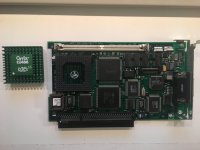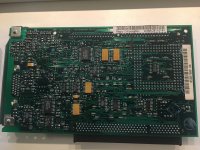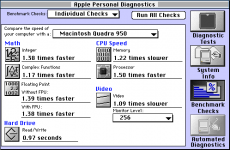jeremywork
Well-known member
I finally acquired a Reply extender for my DOS card- the original Reply card (without the Vibra 16 module, so maybe Houdini I) was also included with a Cyrix DX2-66, but several components were burned away on the back of the board, so I swapped it for the Houdini II with an Intel DX2-66 I already had. The Reply card should be repairable, but something clearly wasn't right (allegedly this was a working pull from a Q900.)


When I installed the Houdini II in my Quadra 950, despite countless permutations of 7.1, 7.5, 7.6, 8.1, open Transport 1.1.1, 1.1.2, 1.3, and DOS drivers 1.5, 1.6.4, and pcSetup217f, the furthest I got was: the PC would begin booting and could be switched to, but as soon as the BIOS would search for devices to boot from, Mac OS would crash. If I started the PC without switching to it, this freeze would still occur, and force quitting Finder would allow me to go back to the PC setup control panel and stop the PC or switch to it. Starting the PC again would generally result in a freeze that would not be recoverable. This persisted with nothing else in the Nubus slots, and only a single Apple SCSI hard drive and Apple CD ROM installed, Floppy drive and Ethernet were working as well. In retrospect, the one thing I didn’t think to try was putting the 950’s serial ports in compatibility mode, but I doubt this would be the cause.
I decided to pull out my Quadra 700 to test with, and then discovered something useful that wasted a couple hours:
Using my Moniswitch setup, I learned the OEM Apple monitor cable I had previously connected to a IIci (with all pins populated) is incapable of transmitting the 832x624 resolution, while working fine at 640x480. This results in a seemingly no-video symptom while the OS boots in background, but after PRAM reset the video works- until the OS tries to reset to the last known setting, when the monitor turns off.
I assumed the Quadra 700 had developed some problem with its VRAM (6x256k SIMMs installed, and I had moved it several times since last booted) and that 24-bit color was what was making the video signal go dead. After twice tearing the machine down to reseat them I tried a Radius video card and booted to the desktop, set the color settings, and as soon as I changed the resolution I figured it out… sigh. Those SIMMs are super-inserted now I guess!
That cable also lead the PC Setup control panel to show a message about the monitor not being compatible. As a bonus though, after using a different cable I was able to run the DOS card in the Q700, despite it having a Quaddoubler/Quadra Overdrive Installed. Internet legend seemed to point to the PDS being disabled when running a Quaddoubler, but the Houdini II seems to work flawlessly so far on 7.6.1/OT1.3/PC Setup 1.6.4 (I blew out a floppy eject gear while installing the DOS drivers, but DOS 6.22 starts and runs while I wait for the 4-pack of replica gears I ordered. I swapped in what turned out to be a spare 800k drive, oops.)
The Quaddoubled Q700 actually arrived to me with a 33MHz Daystar Quadra PDS 128k cache card installed, but no driver was installed on the included hard drive. When I installed the QuadControl cdev, it would immediately hard crash on load, without even a bombshell. It’s not clear to me whether this is a result of the PDS stepping up to the 50MHz speed of the 040 when the bus line is released, and the 33MHz parts on the cache not being able to handle that (typical wisdom says 40MHz is about as fast as it would probably overclock) or if instead it’s because the PDS stays at 25MHz bus speed, and the cache misses every other call when the processor steps up.
In either case, the 33MHz cache works perfectly in the Quadra 950 that rejected the DOS card (with the same Quadcontrol cdev,) so I’m glad that both cards and both machines work one way around, but would still be curious to know if anyone has experience with similar DOS card symptoms (Later finding: the Q950 fails the Logic Board components diagnostic test, which my other 950/PPC passes. The error is not specific, but I have a third spare 950 board... will look further into this. PRAM reset fixed this, which I tried many of during DOS card troubleshooting. Good to know the board passes the test.) Otherwise all I can find points to issues with incompatible Nubus cards. I can confirm that the freeze happens much earlier if a Nubus Video card is present- nearly instantly, as the screen just begins to fade on its way to switch to the PC environment.


The Q700 was benchmarked while the DOS environment was running, so the Quaddoubler is operating normally.
Also side-note: The Q700's case door essentially closes without needing modification, It's just very difficult to align correctly, as there is essentially no clearance between the end of the SIMM slot and the card guide on the case lid. I've found success closing it with the tabs not quite inserted (lid overhanging the front of the case a smidge,) and then sliding it back as the door is nearly closed. This difficult alignment appears to be why some sources say you can squeeze the lid closed, while others say it's completely impossible.


When I installed the Houdini II in my Quadra 950, despite countless permutations of 7.1, 7.5, 7.6, 8.1, open Transport 1.1.1, 1.1.2, 1.3, and DOS drivers 1.5, 1.6.4, and pcSetup217f, the furthest I got was: the PC would begin booting and could be switched to, but as soon as the BIOS would search for devices to boot from, Mac OS would crash. If I started the PC without switching to it, this freeze would still occur, and force quitting Finder would allow me to go back to the PC setup control panel and stop the PC or switch to it. Starting the PC again would generally result in a freeze that would not be recoverable. This persisted with nothing else in the Nubus slots, and only a single Apple SCSI hard drive and Apple CD ROM installed, Floppy drive and Ethernet were working as well. In retrospect, the one thing I didn’t think to try was putting the 950’s serial ports in compatibility mode, but I doubt this would be the cause.
I decided to pull out my Quadra 700 to test with, and then discovered something useful that wasted a couple hours:
Using my Moniswitch setup, I learned the OEM Apple monitor cable I had previously connected to a IIci (with all pins populated) is incapable of transmitting the 832x624 resolution, while working fine at 640x480. This results in a seemingly no-video symptom while the OS boots in background, but after PRAM reset the video works- until the OS tries to reset to the last known setting, when the monitor turns off.
I assumed the Quadra 700 had developed some problem with its VRAM (6x256k SIMMs installed, and I had moved it several times since last booted) and that 24-bit color was what was making the video signal go dead. After twice tearing the machine down to reseat them I tried a Radius video card and booted to the desktop, set the color settings, and as soon as I changed the resolution I figured it out… sigh. Those SIMMs are super-inserted now I guess!
That cable also lead the PC Setup control panel to show a message about the monitor not being compatible. As a bonus though, after using a different cable I was able to run the DOS card in the Q700, despite it having a Quaddoubler/Quadra Overdrive Installed. Internet legend seemed to point to the PDS being disabled when running a Quaddoubler, but the Houdini II seems to work flawlessly so far on 7.6.1/OT1.3/PC Setup 1.6.4 (I blew out a floppy eject gear while installing the DOS drivers, but DOS 6.22 starts and runs while I wait for the 4-pack of replica gears I ordered. I swapped in what turned out to be a spare 800k drive, oops.)
The Quaddoubled Q700 actually arrived to me with a 33MHz Daystar Quadra PDS 128k cache card installed, but no driver was installed on the included hard drive. When I installed the QuadControl cdev, it would immediately hard crash on load, without even a bombshell. It’s not clear to me whether this is a result of the PDS stepping up to the 50MHz speed of the 040 when the bus line is released, and the 33MHz parts on the cache not being able to handle that (typical wisdom says 40MHz is about as fast as it would probably overclock) or if instead it’s because the PDS stays at 25MHz bus speed, and the cache misses every other call when the processor steps up.
In either case, the 33MHz cache works perfectly in the Quadra 950 that rejected the DOS card (with the same Quadcontrol cdev,) so I’m glad that both cards and both machines work one way around, but would still be curious to know if anyone has experience with similar DOS card symptoms (


The Q700 was benchmarked while the DOS environment was running, so the Quaddoubler is operating normally.
Also side-note: The Q700's case door essentially closes without needing modification, It's just very difficult to align correctly, as there is essentially no clearance between the end of the SIMM slot and the card guide on the case lid. I've found success closing it with the tabs not quite inserted (lid overhanging the front of the case a smidge,) and then sliding it back as the door is nearly closed. This difficult alignment appears to be why some sources say you can squeeze the lid closed, while others say it's completely impossible.
Last edited by a moderator:
